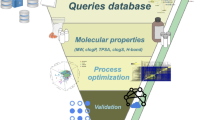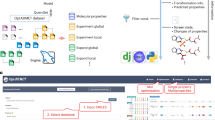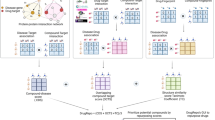Abstract
Bioactive molecules such as drugs, pesticides and food additives are produced in large numbers by many commercial and academic groups around the world. Enormous quantities of data are generated on the biological properties and quality of these molecules. Access to such data — both on licensed and commercially available compounds, and also on those that fail during development — is crucial for understanding how improved molecules could be developed. For example, computational analysis of aggregated data on molecules that are investigated in drug discovery programmes has led to a greater understanding of the properties of successful drugs. However, the information required to perform these analyses is rarely published, and when it is made available it is often missing crucial data or is in a format that is inappropriate for efficient data-mining. Here, we propose a solution: the definition of reporting guidelines for bioactive entities — the Minimum Information About a Bioactive Entity (MIABE) — which has been developed by representatives of pharmaceutical companies, data resource providers and academic groups.
This is a preview of subscription content, access via your institution
Access options
Subscribe to this journal
Receive 12 print issues and online access
$209.00 per year
only $17.42 per issue
Buy this article
- Purchase on Springer Link
- Instant access to full article PDF
Prices may be subject to local taxes which are calculated during checkout
Similar content being viewed by others
References
Hopkins, A. L. & Groom, C. R. The druggable genome. Nature Rev. Drug Discov. 1, 727–730 (2002).
Hajduk, P. J., Huth, J. R., & Tse, C. Predicting protein druggability. Drug Discov. Today 10, 1675–1682 (2005).
Schmidtke, P. & Barril, X. Understanding and predicting druggability. A high-throughput method for detection of drug binding sites. J. Med. Chem. 53, 5858–5867 (2010).
Halgren, T. A. Identifying and characterizing binding sites and assessing druggability. J. Chem. Inf. Model. 49, 377–389 (2009).
Zhang, Z. & Grigorov, M. G. Similarity networks of protein binding sites. Proteins 62, 470–478 (2006).
Overington, J. P., Al-Lazikani, B. & Hopkins, A. L. How many drug targets are there? Nature Rev. Drug Discov. 5, 993–996 (2006).
The UniProt Consortium. Ongoing and future developments at the Universal Protein Resource. Nucleic Acids Res. 39, D214–D219 (2010).
Berriman, M. et al. The genome of the blood fluke Schistosoma mansoni. Nature 460, 352–358 (2009).
Brazma, A. et al. Minimum information about a microarray experiment (MIAME) — toward standards for microarray data. Nature Genet. 29, 365–371 (2001).
Degtyarenko, K. et al. ChEBI: a database and ontology for chemical entities of biological interest. Nucleic Acids Res. 36, D344–D350 (2008).
Sayers, E. W. et al. Database resources of the National Center for Biotechnology Information. Nucleic Acids Res. 39, D38–D51 (2011).
Seiler, K. P. et al. ChemBank: a small-molecule screening and cheminformatics resource database. Nucleic Acids Res. 36, D351–D359 (2008).
Pederson, F., de Brujin, J., Munn, S. & van Leeuwen, K. Assessment of additional testing needs under REACH. Effects of (Q)SAR, risk based testing and voluntary industry activity. European Commission report EUR 20863 (2003).
Vizcaino, J. A., Martens, L., Hermjakob, H., Julian, R. K. & Paton, N. W. The PSI formal document process and its implementation on the PSI website. Proteomics 7, 2355–2357 (2007).
Yeung, B. K. et al. Spirotetrahydro β-carbolines (spiroindolones): a new class of potent and orally efficacious compounds for the treatment of malaria. J. Med. Chem. 53, 5155–5164 (2010).
Kerrien, S. et al. Broadening the horizon — level 2.5 of the HUPO-PSI format for molecular interactions. BMC Biol. 5, 44 (2007).
Aranda, B. et al. PSICQUIC and PSISCORE: accessing and scoring molecular interactions. Nature Methods 8, 528–529 (2011).
Croft, D. et al. Reactome: a database of reactions, pathways and biological processes. Nucleic Acids Res. 39, D691–D697 (2011).
Taylor, C. F. et al. Promoting coherent minimum reporting guidelines for biological and biomedical investigations: the MIBBI project. Nature Biotech. 26, 889–896 (2008).
Orchard, S. et al. The minimum information required for reporting a molecular interaction experiment (MIMIx). Nature Biotech. 25, 894–898 (2007).
Bourbeillon, J. et al. Minimum Information about a protein affinity reagent (MIAPAR). Nature Biotech. 28, 650–653 (2010).
Schuffenhauer, A. et al. An ontology for pharmaceutical ligands and its application for in silico screening and library design. J. Chem. Inf. Comput. Sci. 42, 947–955 (2002).
Qi, D. et al. An ontology for description of drug discovery investigations. J. Integr. Bioinform. 25 Mar 2010 (doi:10.2390/biecoll-jib-2010-126).
Weininger, D. SMILES, a chemical language and information system. 1. Introduction to methodology and encoding rules. J. Chem. Inf. Comput. Sci. 28, 31–36 (1988).
Stein, S. E., Heller, S. R. & Tchekhovskoi, D. An open standard for chemical structure representation: the IUPAC chemical identifier. Proceedings of the 2003 International Chemical Information Conference (Nîmes), Infonortics, 131–143 (2003).
Inglese, J., Shamu, C. E. & Guy, R. K. Reporting data from high-throughput screening of small-molecule libraries. Nature Chem. Biol. 3, 438–441 (2007).
Gene Ontology Consortium. The Gene Ontology in 2010: extensions and refinements. Nucleic Acids Res. 38, D331–D335 (2010).
Acknowledgements
This work has, in part, been funded by the European Commission under the Proteomics Standards Initiative and International Molecular Exchange (PSIMEx), contract number FP7-HEALTH-2007-223411.
Author information
Authors and Affiliations
Corresponding author
Ethics declarations
Competing interests
The authors declare no competing financial interests.
Supplementary information
Supplementary information Table S1
Sample MIABE file exemplifying data extracted from PMID: 20568778 (PDF 423 kb)
Supplementary information Table S2
Binding affinity to human ERG (XML 45 kb)
Rights and permissions
About this article
Cite this article
Orchard, S., Al-Lazikani, B., Bryant, S. et al. Minimum information about a bioactive entity (MIABE). Nat Rev Drug Discov 10, 661–669 (2011). https://doi.org/10.1038/nrd3503
Published:
Issue Date:
DOI: https://doi.org/10.1038/nrd3503
This article is cited by
-
The Alexandria library, a quantum-chemical database of molecular properties for force field development
Scientific Data (2018)
-
VB-MK-LMF: fusion of drugs, targets and interactions using variational Bayesian multiple kernel logistic matrix factorization
BMC Bioinformatics (2017)
-
Propelling the paradigm shift from reductionism to systems nutrition
Genes & Nutrition (2017)
-
Data integration in biological research: an overview
Journal of Biological Research-Thessaloniki (2015)
-
Curation of chemogenomics data
Nature Chemical Biology (2015)



